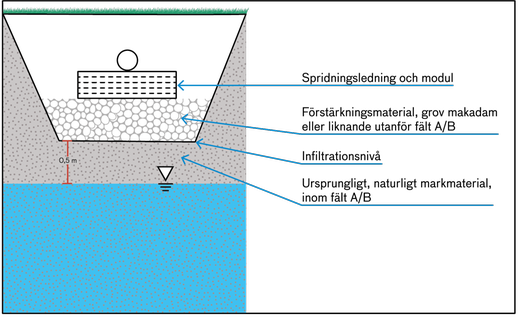Your cart is currently empty!
What should be the distance to the groundwater surface

The general guidelines on small sewers (HVMFS 2016:17) state that “The distance between the infiltration level and the highest groundwater level (…) should not be less than 1 m”. The reason for this is that it is in the unsaturated zone (the zone before the wastewater reaches the groundwater) that the main treatment of both infectious agents and other substances takes place.
Since the size of the unsaturated zone is of great importance for an infiltration facility to function as intended, this prerequisite is also an important component of the siting investigation. In order to establish that the applied for site is suitable and that a sufficiently large unsaturated zone can be achieved, it is recommended that an investigation of the expected highest groundwater level is carried out in connection with the design of a new facility.
Such an investigation should include:
Determination of the groundwater level in a test pit/groundwater pipe on at least two occasions,
addition because the groundwater level may have been read at a time when the aquifer was not normally full, and
addition in the case of fine-grained soil (in field B) because the infiltration itself raises the groundwater level.
A description of a method for such an investigation is given in HaV’s guidance on the assessment of small sewers.
If, after such an investigation, the protective distance between the groundwater level and the infiltration level is deemed to be sufficient and all other conditions for permissibility are met, a permit should be granted. To ensure that the facility is also placed at the right distance from the groundwater, the permit can be associated with a condition that regulates this. In new permit assessments of infiltration facilities, a condition on distance to the groundwater surface could be formulated as follows:
The distance between the infiltration level and the groundwater surface shall be at least 1 m, except for short periods (maximum 2 months in a year). The distance between the infiltration level and the groundwater surface shall never be less than 0,5 m.
What is meant by infiltration rate?
Regarding the vertical protection distance, it is important to note that it is not the distance from the ground surface but the distance from the infiltration level to the groundwater level that is meant, see Figure 9.
In non-conventional ground-based systems, it is not as easy to determine where the infiltration level is. For example, modular spreading layers can be based on the development of a bio-skin in the module itself, so that wastewater treatment already starts there. Sometimes modules or other ground-based technologies can be combined with an underlying coarser spreading layer of, for example, macadam, which can reduce the treatment performance above the groundwater level, see Figure 10. For conventional infiltration, an unusually thick spreading layer can have the same effect by lowering the infiltration level.
If groundwater levels are investigated during the design phase, taking into account fluctuations and the time of year when the investigation is carried out, deviations from the 1 meter unsaturated zone requirement should be unusual when the facility is later in operation. By stating in the above proposed condition that a deviation is allowed for a limited time, it leaves room for extreme events to occur that cannot be foreseen. By stating in the second sentence of the condition that the distance must never be less than 0.5 meters, the proposed condition is also adapted to what is practical for supervision and legally certain for the individual operator. A violation is easy to establish – if the unsaturated zone is less than 0.5 meters, the facility does not comply with the given conditions regardless of the degree of filling in the aquifer. The condition does not contradict the main requirement of 1 meter unsaturated zone in normal years. The proposed wording of the above conditions thus takes into account both what is possible for the operator to comply with and what is possible for the supervisory authority to check. New infiltration facilities should also have a condition that they must have a groundwater pipe so that it is possible to monitor the function.
When inspecting older installations where the investigation of the distance to the groundwater surface may not have been as thorough during the design phase, the question may arise as to what is an acceptable distance to the groundwater surface. There may also not be a groundwater pipe to allow the distance to be checked. The main rule in these cases, as in all other inspections of licensed installations, is that the inspection must be based on how the license and its conditions are formulated. Note that the proposed wording of conditions above for new installations is not directly applicable to older installations.
